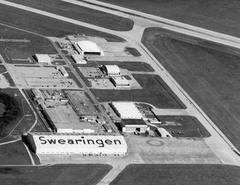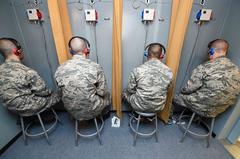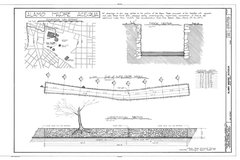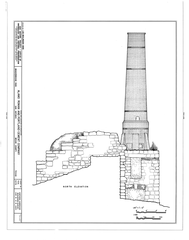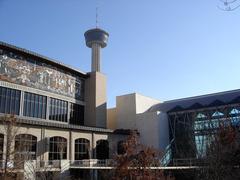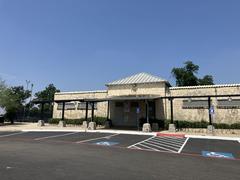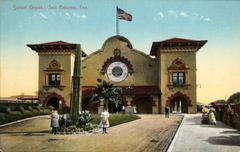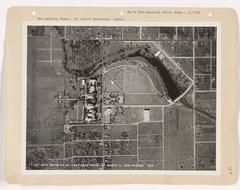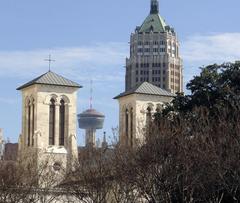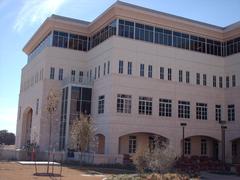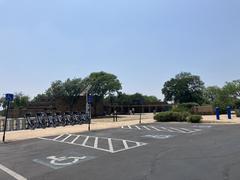
San Antonio International Airport (SAT) Visiting Guide: Tickets, Hours, and More
Date: 14/06/2025
Introduction to San Antonio International Airport
San Antonio International Airport (SAT) is the primary air gateway to San Antonio, Texas—a city celebrated for its vibrant culture, historical significance, and thriving tourism industry. Since its establishment in 1941, SAT has evolved from a small municipal airfield into a bustling international airport, connecting millions of leisure and business travelers annually to destinations across the globe. Located about eight miles north of downtown, SAT plays a pivotal role in supporting the region’s economic growth and fostering cultural exchange. In 2023 alone, San Antonio welcomed over 37 million visitors, underscoring the airport’s significance not only as a transportation hub but as a catalyst for the local economy (visitsanantonio.com; worldtravelguide.net).
The airport is undergoing transformative developments through its Terminal Development Program (TDP), branded as ELEVATE/SAT—a $1.68 billion investment and the most significant capital initiative in the city’s history. The TDP aims to modernize SAT’s infrastructure, expand capacity, and enhance the passenger experience through 2045 (flysanantonio.com; corgan.com). In addition, SAT has introduced innovative programs such as the SAT Pass Program, which allows non-ticketed visitors access to post-security areas, strengthening community connections and improving the overall traveler experience (allofsa.net).
SAT also serves as the gateway to San Antonio’s world-renowned attractions, including The Alamo—a site central to Texas history and culture, offering free admission and a variety of guided experiences (thealamo.org; visitsanantonio.com). This guide provides up-to-date details on airport logistics, visiting hours, ticketing, accessibility, and travel to key attractions, ensuring every visitor enjoys a seamless and enriching experience in San Antonio (sanantonioreport.org).
Contents
- Introduction
- Historical Evolution of San Antonio International Airport
- Early Beginnings and Growth
- Expansion and Modernization
- Recent Developments and Major Projects
- Terminal Development Program (TDP) and ELEVATE/SAT
- Key Features of the Expansion
- Economic and Community Impact
- Passenger Experience Innovations
- Visitor Information
- Visiting Hours
- Ticketing and Airlines
- Accessibility
- Transportation to Historical Sites
- Travel Tips
- Infrastructure and Connectivity Improvements
- Cultural and Regional Significance
- FAQs
- Visiting The Alamo: Hours, Tickets, and More
- History and Significance
- Hours and Admission
- Tours and Visitor Experiences
- Nearby Attractions
- Amenities
- Photography and Tips
- FAQs
- Exploring Other Historical Sites
- Conclusion
Historical Evolution of San Antonio International Airport
Early Beginnings and Growth
San Antonio International Airport opened in 1941 as a modest municipal airfield strategically located north of downtown. Its importance quickly grew during World War II, serving both military and civilian aviation needs. In the following decades, as San Antonio’s population and tourism sector expanded, SAT responded with new terminals and runways to meet growing demand (airportslounges.com; worldtravelguide.net).
Expansion and Modernization
By the late 20th century, SAT had solidified its status as a regional aviation leader. The addition of Terminals A and B improved passenger flow and amenities. Security protocols changed after 9/11, limiting terminal access to ticketed passengers, but the airport continued to innovate, supporting millions of annual visitors and contributing to San Antonio’s $21.5 billion tourism economy (visitsanantonio.com).
Recent Developments and Major Projects
Terminal Development Program (TDP) and ELEVATE/SAT
To accommodate record-setting passenger volumes and regional growth, SAT launched the ELEVATE/SAT Terminal Development Program (flysanantonio.com). This 20-year master plan, approved by the city council, will expand and modernize the airport through 2045.
Key Features
- New Terminal Complex: Up to 17 additional gates are planned, with completion targeted for 2028, enhancing domestic and international connectivity (simpleflying.com).
- Terminal A Redevelopment: Terminal A will be rebuilt, introducing approximately 41,000 square feet of new restaurants, bars, and retail spaces (visitsanantonio.com).
- Ground Transportation Center: A new center will offer up to 2,000 parking spaces and efficient access to taxis, shuttles, and rideshares.
- Runway Expansion: Plans include extending a primary runway for larger aircraft and more direct international flights (forbes.com).
- Sustainable Design: The new terminal, designed by Corgan and Lake Flato, will emphasize sustainability and reflect San Antonio’s unique character (corgan.com).
Economic and Community Impact
The TDP represents a $1.68 billion investment—the largest in San Antonio’s history—expected to generate thousands of construction and long-term jobs and support over 147,000 total jobs in the aviation and hospitality sectors (corgan.com; flysanantonio.com).
Passenger Experience Innovations
SAT Pass Program
Launched in 2025, the SAT Pass Program allows up to 50 non-ticketed visitors per day to access post-security terminal areas—reinstating a privilege not seen since 2001 (allofsa.net; sa.gov). This initiative enhances traveler satisfaction and community engagement.
Enhanced Amenities and Lounges
SAT features the United Club (Terminal B) and the USO Lounge for military personnel. The upcoming expansion will add more dining and retail options, with a focus on local culinary and cultural experiences (airportslounges.com).
Visitor Information
Visiting Hours
SAT operates 24/7, ensuring flexibility for travelers. Airline ticket counters and security checkpoints generally open early morning and close late evening; check with your airline for exact ticketing hours.
Ticketing and Airlines
Travelers can purchase tickets directly through airline websites, travel agencies, or at SAT’s self-service kiosks and ticket counters. SAT is served by major domestic and international airlines.
Accessibility
SAT is ADA-compliant, providing wheelchair assistance, accessible restrooms, parking, elevators, and other services for travelers with disabilities. Contact your airline or the airport in advance if special assistance is needed.
Transportation to Historical Sites
The airport offers convenient access to San Antonio’s premier attractions, including The Alamo, the San Antonio Missions, and the River Walk. Transportation options include taxi, rideshare, VIA Metropolitan Transit (bus 5), and rental cars. Most downtown destinations are a 15-minute drive from SAT (worldtravelguide.net).
Travel Tips
- Arrive at least two hours before domestic and three hours before international flights.
- Use the SAT Pass Program to meet friends or family inside secure areas.
- Take advantage of the new ground transportation center.
- Enjoy local dining and shopping options within the terminals.
Infrastructure and Connectivity Improvements
SAT is easily accessible via Interstates 10, 35, and Highway 281. The ongoing construction of a new ground transportation center and runway expansions will further streamline connectivity. Public transportation is available through VIA Metropolitan Transit, and new facilities will accommodate increasing passenger volumes (simpleflying.com).
Cultural and Regional Significance
SAT not only serves as a transportation hub, but also as a gateway to San Antonio’s diverse cultural heritage. Its modernization reflects the city’s commitment to welcoming visitors with both world-class facilities and a distinctly local flavor (foratravel.com).
Frequently Asked Questions (FAQ)
Q: What are SAT’s visiting hours?
A: The airport is open 24 hours; ticket counters and security have specific hours—check with your airline for details.
Q: How do I buy tickets?
A: Purchase tickets online, through travel agencies, or at airport kiosks and counters.
Q: Is SAT accessible for people with disabilities?
A: Yes, with comprehensive accessibility services and facilities.
Q: Can non-travelers enter secure terminal areas?
A: Yes, via the SAT Pass Program (limited daily availability).
Q: How do I get to downtown attractions from SAT?
A: Use taxis, rideshare, public transit, or rental cars—most sites are about 15 minutes away.
Regional Significance and Economic Impact
SAT is a vital engine of regional growth, handling over 10 million passengers annually and supporting both local tourism and business development (San Antonio Report). Its expanding international routes foster cultural and economic ties with Mexico, Europe, and beyond (San Antonio Report). The airport’s TDP is projected to create more than 16,000 jobs during development and generate $2.8 billion in economic activity over 20 years (International Airport Review). Tourism supported by SAT contributes $21.5 billion to the local economy and more than 150,000 jobs (San Antonio Report).
Modernization efforts, inclusive planning, and expanded air service position San Antonio as an increasingly attractive destination for business, conventions, and leisure travel (Visit San Antonio; Airport Gurus).
Visiting The Alamo: San Antonio’s Iconic Landmark
History and Significance
The Alamo, originally established as Mission San Antonio de Valero in the 18th century, gained fame as the site of the 1836 Battle of the Alamo—a pivotal event in the Texas Revolution. Today, it stands as a symbol of courage and is one of the most visited historical sites in the United States (thealamo.org).
Hours and Admission
- General Hours: Open daily from 9:00 a.m. to 5:30 p.m. (last entry at 5:00 p.m.).
- Closed: Thanksgiving Day, Christmas Day, and New Year’s Day.
- Admission: Free entry to the Alamo Church and grounds.
Guided tours and museum exhibits may require a ticket, available online or at the site.
Tours and Visitor Experiences
- Self-Guided Tours: Explore at your own pace with informative signage and interactive exhibits.
- Audio Tours: Available in multiple languages.
- Ranger-Led Tours: Gain deeper insight into the Alamo’s history.
- Special Events: Includes reenactments, lectures, and cultural programs.
Nearby Attractions
- San Antonio Missions National Historical Park: Four other Spanish colonial missions nearby (nps.gov/saan).
- River Walk: Lively pedestrian walkways along the San Antonio River.
- San Fernando Cathedral and Spanish Governor’s Palace: Historic sites within walking distance.
Visitor Amenities
- Accessibility: ADA-compliant with ramps, accessible restrooms, and services for visitors with disabilities.
- Dining: Numerous local eateries nearby featuring Tex-Mex and local cuisine.
- Gift Shop: On-site, offering souvenirs and Texas-themed merchandise.
Photography and Tips
- Photography: Permitted throughout the grounds; flash and tripods are not allowed inside the chapel.
- Best Times: Early morning and late afternoon for fewer crowds and optimal lighting.
- Visitor Tips: Wear comfortable shoes, bring water, and plan ahead for peak tourist seasons.
FAQs
Q: Is there a fee to enter the Alamo?
A: No, general admission is free; guided tours and some exhibits require tickets.
Q: Can I book tours online?
A: Yes, visit the official website for advance bookings.
Q: Is the Alamo accessible for wheelchairs?
A: Yes, with ADA-compliant amenities.
Q: Are pets allowed?
A: Only service animals are permitted.
Q: Where can I park?
A: Several public garages and lots are nearby; street parking is limited.
Exploring Other San Antonio Historical Sites
In addition to the Alamo, notable historical attractions include:
- San Fernando Cathedral
- Spanish Governor’s Palace
- La Villita Historic Arts Village
Discover more: San Antonio Historical Sites Guide
Conclusion
San Antonio International Airport is transforming into a modern, efficient, and welcoming gateway that honors its historical legacy while driving future growth. With its ambitious expansion, enhanced amenities, and innovative programs, SAT is poised to meet the needs of over 10 million passengers annually and sustain San Antonio’s booming tourism and business sectors.
Visitors benefit from seamless access to the city’s rich heritage, with The Alamo and other landmarks just minutes away. Whether you’re traveling for business, pleasure, or historical exploration, SAT and San Antonio offer a unique blend of convenience, culture, and hospitality.
For real-time updates, travel tips, and exclusive offers, download the Audiala app and follow official channels for the latest on San Antonio International Airport and the city’s attractions.
Sources and Further Reading
- San Antonio International Airport: Terminal Development
- San Antonio Tourism Economic Impact 2023
- Meet the Architects Behind San Antonio’s Newest Airport Terminal
- SAT Pass Program Launch
- San Antonio International Airport Groundbreaking
- Adding More International Flights at SAT
- Downtown San Antonio Tourism Impact
- SAT Expansion List
- Experience San Antonio Guide
- The Alamo Official Website
- San Antonio Missions National Historical Park
- Visit San Antonio Historical Sites Guide
